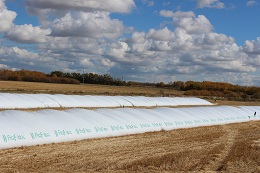Storage principles
Silage making is a conservation technique, based on storage in the absence of oxygen, instead bacteria ferment the sugars to acids that lower the pH of the forage. As this process continues, pH levels decrease until a stable environment occurs. This also stops the growth of unwanted microorganisms. As long as no air enters, the silage is preserved as a high nutrition cattle feed.
Grain bags provide a controlled atmosphere which is low in oxygen. During the respiratory process of grain, insects, fungi and oxygen is consumed and carbon dioxide is released. After this process has finished, grain nutrients and quality are kept stable. This is the main difference of the bagging system, in comparison to the traditional storage system, where exchanges of gases and moisture keeps on taking place.
Periodic Control
It is important to protect the bags from possible damage. Check the bags for damage frequently and repair any damage immediately.
Animals can cause a lot of damage. Protect the area from livestock and domestic animals. An electric fence or bird net may be needed.
Avoid attracting rodents or small mammals by keeping grass mown, or place bags on gravel or concrete pads.
Close the bag after each feed-out and clean up spilled forage so that rodents are not attracted to the area.
Do not use weed killer around the bags as the chemicals may lead to failure of the bag.
Do not let children play on, or walk on the bags.
Fix the loose ends with weights to prevent wind damage and check the bags after storms.
Inspect on a regular basis. Mend holes as appropriate with patch tape. Do not use duct tape as it has no UV stability.
Bag Location
This can have an immediate effect on the quality of storage afterwards, therefore choose the right location:
- Place bags on a well-drained and hard surface. It should be free of stones and sharp objects that could damage the bag. The area should be level so the contents of the bag cannot move
- Make sure fields are stubble and weed free
- Locate bags in an area that allows for easy removal of feeds
- Leave a passage between bags for ease of access
- Orient bags north to south to allow for even heat spread
- Ideally, do not place the AgFlex bags under trees, as damage could occur from small branches
- Locations near busy roads or high passage areas reduces the amount of animal activity




